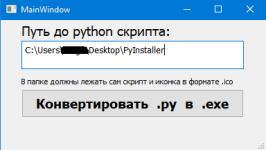# -*- coding: utf-8 -*-
# Form implementation generated from reading ui file 'untitled.ui'
#
# Created by: PyQt5 UI code generator 5.12.2
#
# WARNING! All changes made in this file will be lost!
from PyQt5 import QtCore, QtGui, QtWidgets
class Ui_MainWindow(object):
def setupUi(self, MainWindow):
MainWindow.setObjectName("MainWindow")
MainWindow.setFixedSize(420, 364)
self.centralwidget = QtWidgets.QWidget(MainWindow)
self.centralwidget.setObjectName("centralwidget")
self.textEdit = QtWidgets.QTextEdit(self.centralwidget)
self.textEdit.setGeometry(QtCore.QRect(20, 40, 381, 41))
font = QtGui.QFont()
font.setPointSize(15)
self.textEdit.setFont(font)
self.textEdit.setObjectName("textEdit")
self.label = QtWidgets.QLabel(self.centralwidget)
self.label.setGeometry(QtCore.QRect(30, 10, 361, 31))
font = QtGui.QFont()
font.setPointSize(10)
font.setBold(True)
font.setWeight(75)
self.label.setFont(font)
self.label.setObjectName("label")
self.textEdit_2 = QtWidgets.QTextEdit(self.centralwidget)
self.textEdit_2.setGeometry(QtCore.QRect(20, 110, 161, 41))
font = QtGui.QFont()
font.setPointSize(16)
font.setBold(False)
font.setWeight(50)
self.textEdit_2.setFont(font)
self.textEdit_2.setObjectName("textEdit_2")
self.label_2 = QtWidgets.QLabel(self.centralwidget)
self.label_2.setGeometry(QtCore.QRect(30, 90, 141, 16))
font = QtGui.QFont()
font.setPointSize(10)
font.setBold(True)
font.setWeight(75)
self.label_2.setFont(font)
self.label_2.setObjectName("label_2")
self.textEdit_3 = QtWidgets.QTextEdit(self.centralwidget)
self.textEdit_3.setGeometry(QtCore.QRect(20, 180, 381, 71))
font = QtGui.QFont()
font.setPointSize(16)
self.textEdit_3.setFont(font)
self.textEdit_3.setObjectName("textEdit_3")
self.label_3 = QtWidgets.QLabel(self.centralwidget)
self.label_3.setGeometry(QtCore.QRect(30, 160, 141, 16))
font = QtGui.QFont()
font.setPointSize(10)
font.setBold(True)
font.setWeight(75)
self.label_3.setFont(font)
self.label_3.setObjectName("label_3")
self.label_4 = QtWidgets.QLabel(self.centralwidget)
self.label_4.setGeometry(QtCore.QRect(20, 260, 381, 21))
font = QtGui.QFont()
font.setPointSize(8)
self.label_4.setFont(font)
self.label_4.setObjectName("label_4")
self.pushButton = QtWidgets.QPushButton(self.centralwidget)
self.pushButton.setGeometry(QtCore.QRect(20, 290, 381, 51))
font = QtGui.QFont()
font.setPointSize(20)
font.setBold(True)
font.setUnderline(False)
font.setWeight(75)
self.pushButton.setFont(font)
self.pushButton.setObjectName("pushButton")
MainWindow.setCentralWidget(self.centralwidget)
self.menubar = QtWidgets.QMenuBar(MainWindow)
self.menubar.setGeometry(QtCore.QRect(0, 0, 420, 21))
self.menubar.setObjectName("menubar")
MainWindow.setMenuBar(self.menubar)
self.statusbar = QtWidgets.QStatusBar(MainWindow)
self.statusbar.setObjectName("statusbar")
MainWindow.setStatusBar(self.statusbar)
self.retranslateUi(MainWindow)
QtCore.QMetaObject.connectSlotsByName(MainWindow)
def retranslateUi(self, MainWindow):
_translate = QtCore.QCoreApplication.translate
MainWindow.setWindowTitle(_translate("MainWindow", "WhatsAppSpammer"))
self.textEdit.setHtml(_translate("MainWindow", "<!DOCTYPE HTML PUBLIC \"-//W3C//DTD HTML 4.0//EN\" \"http://www.w3.org/TR/REC-html40/strict.dtd\">\n"
"<html><head><meta name=\"qrichtext\" content=\"1\" /><style type=\"text/css\">\n"
"p, li { white-space: pre-wrap; }\n"
"</style></head><body style=\" font-family:\'MS Shell Dlg 2\'; font-size:15pt; font-weight:400; font-style:normal;\">\n"
"<p style=\"-qt-paragraph-type:empty; margin-top:0px; margin-bottom:0px; margin-left:0px; margin-right:0px; -qt-block-indent:0; text-indent:0px;\"><br /></p></body></html>"))
self.label.setText(_translate("MainWindow", "ВВЕДИТЕ ИМЯ ЖЕРТВЫ (ТАК ЖЕ КАК В СПРАВОЧНИКЕ):"))
self.textEdit_2.setHtml(_translate("MainWindow", "<!DOCTYPE HTML PUBLIC \"-//W3C//DTD HTML 4.0//EN\" \"http://www.w3.org/TR/REC-html40/strict.dtd\">\n"
"<html><head><meta name=\"qrichtext\" content=\"1\" /><style type=\"text/css\">\n"
"p, li { white-space: pre-wrap; }\n"
"</style></head><body style=\" font-family:\'MS Shell Dlg 2\'; font-size:16pt; font-weight:400; font-style:normal;\">\n"
"<p style=\"-qt-paragraph-type:empty; margin-top:0px; margin-bottom:0px; margin-left:0px; margin-right:0px; -qt-block-indent:0; text-indent:0px;\"><br /></p></body></html>"))
self.label_2.setText(_translate("MainWindow", "КОЛ-ВО СООБЩЕНИЙ:"))
self.label_3.setText(_translate("MainWindow", "ТЕКСТ СООБЩЕНИЯ:"))
self.label_4.setText(_translate("MainWindow", "УБЕДИТЕСЬ ЧТО QR-КОД ОТСКАНИРОВАН И ВЫ НА СТРАНИЦЕ WHATSAPP!"))
self.pushButton.setText(_translate("MainWindow", "START SPAM"))




